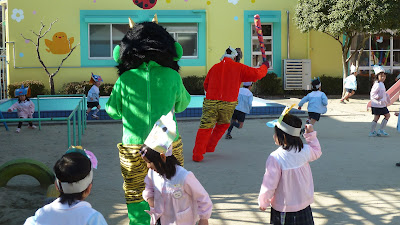February 3rd marks another traditional Japanese holiday. This one, called
Setsubun, is how we in Japan prepare for the lunar new year. First let me tell you of my experience at Hotouku Kindergarten.
In the morning, all the students were hauled out to the playground sporting their self designed and created
oni (demon) headdresses. The principal shared many words of what is possibly inspiration, but I didn't understand. As he finished his speech a loud thumping began reverberating through the intercom. All of the children were looking around in dreaded apprehension for the event they were about to embark on. After a few agonizing minutes a gym teacher and bus driver emerged as costumed head to toe
oni, clubs clutched in the palms. It was at this point that the running and screaming began as the
oni chased the children around the playground, scaring the evil spirits right out of them. Earlier in the morning we were all given a handful, or two, of roasted soybeans which were now being pelted at
oni. Mind that some of the students are as young as three years olds and can't comprehend that fact that these are merely their beloved caretakers. They were crying and screaming for their mamas while being chased around the dirt courtyard. Many sought refuge by huddling near their teachers. The older kids were of course, quite enjoying the opportunity to hurdle beans to keep the evil spirits at bay. This continued for a good 20-30 minutes before the
oni snuck back into the school, possibly waiting in a classroom to catch their breath and frighten students as they return. As we sat down for lunch I was gently instructed by Nami to eat as many soybeans as there have been years in my life, another attempt to ward off bad spirits and luck.
The explanation I was given at school didn't quite satisfy my curiosity as to why this was happening, other than being told it was to purify our homes and ourselves of evil spirits in preparation for spring. I learned the following information with some help from
Kansai Scene, our favorite local English magazine about life in
Kansai.
In both Chinese and Japanese philosophy it is believed that during the changing of the seasons the border between the spirit world and our own thins, making it easier to pass between the two. This then becomes the prime time to expel those wicked spirits and influences that have been plaguing us through the long cold months.
The bean throwing tradition comes from the Muromachi period (15th and 16th C.) which have similarities to a
Noh Drama. In the play, an old woman is visited by a mysterious stranger carrying a magic mallet. With the mallet, he proceeds to make an exceptionally beautiful kimono. Desiring both the mallet and kimono, the woman gets the man drunk until he realizes what is going on and reveals himself in his true form, as a demon. In her panic the woman reaches for the nearest weapon to defend herself, a handful of dried beans, and is somehow able to drive off the ogre. In this way she loses the things she coveted, but also loses the evil emotion of greed and gains the purity of wisdom.
One tradition I didn't have the chance to participate in is one from the Edo period. Each year in the lunar calender is associated with an auspicious compass direction. To combat this one is suppose to stand towards said direction while eating an entire
makizushi, or uncut sushi roll. Some say this ceremony stems from an Osaka geisha who performed this ritual as a sort of love spell. Although uncertain about her reasons, rice and seaweed are considered to be natural gifts from the land and sea. Eating them during such a time most likely cleanses us from the inside out.
These festivities not only occur in kindergartens and schools, but also at homes with the man of the house donning an
oni mask to scare their families and rid their homes of these sinister spirits. There are also celebrations at temples and shrines throughout the country. Our favorite aquarium even features diving
oni who clean the tanks for the days leading up to
Setsubun. I can't say whether it's from this cleansing day or just that the cold, snowless winter is weighing on me, but I have never been more ready for the warming months of spring and the delicate blossoms that accompany them.














































